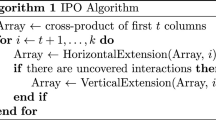Abstract
Covering arrays are used for generating tests for interfaces with a large number of parameters. In this paper, a new method is described for constructing homogeneous and heterogeneous covering arrays that is based on a combination of combinatorial and optimization methods. In a wide class of particular cases, the method speeds up the construction of arrays several times (depending on a particular case) compared with well-known, widely used optimization methods. In most cases, the sizes of the arrays obtained are approximately the same as those of the arrays constructed by other optimization methods; in a number of particular cases, one could obtain arrays that are smaller by 5–15%. The application range of the new method is analyzed.
Similar content being viewed by others
References
Zelenov, S.V. and Zelenova, S.A., Automatic generation of positive and negative tests for testing syntactic analysis phase, Tr. Inst. Sist. Progr., Ross. Akad. Nauk, 2004, vol. 8, no. 1, pp. 41–58.
Hoffman, D., Sobotkiewicz, L., Wang Hong-Yi, Strooper, P., Bazdell, G., and Stevens, B., Test generation with context free grammars and covering arrays, Testing: Academic and Industrial Conf.-Practice and Research Techniques, Windsor, UK, 2009, pp. 83–87.
Ammann, P. and Offutt, J., Using formal methods to derive test frames in category-partition testing, Safety, Reliability, Fault Tolerance, Concurrency, and Real Time Security: Proc. of the 9-th Ann. Conf. on Computer Assurance (COMPASS’ 94), 1994, pp. 69–79.
Kulyamin, V.V. and Petukhov, A.A., A survey of methods for constructing covering arrays, Program. Comput. Software, 2011, vol. 37, no. 3, pp. 121–146.
Martirosyan, S. and Van Trung, T., On t-covering arrays, Designs, Codes and Cryptography, 2004, vol. 32, no. 1–3, pp. 323–339.
Hartman, A. and Raskin, L., Problems and algorithms for covering arrays, Discrete Math., 2004, vol. 284, no. 1–3, pp. 149–156.
Colbourn, C.J., Combinatorial aspects of covering arrays, Le Matematiche (Catania), 2004, vol. 58, pp. 121–167.
Grindal, M., Offutt, A.J., and Andler, S.F., Combination testing strategies: A survey, Software Testing, Verification, and Reliability, 2005, vol. 15, no. 3, pp. 167–199.
Hartman, A., Software and hardware testing using combinatorial covering suites, Proc. of Graph Theory, Combinatorics and Algorithms: Interdisciplinary Applications, 2005, pp. 266–327.
Dalal, S.R. and Mallows, C.L., Factor-covering designs for testing software, Technometrics, 1998, vol. 40, no. 3, pp. 234–243.
Bryce, R. and Colbourn, C.J., One-test-at-a-time heuristic search for interaction test suites, Proc. of Genetic and Evolutionary Computation Conference (GECCO). Search-Based Software Engineering Track (SBSE), London, England, July 2007, pp. 1082–1089.
Calvagna, A. and Gargantini, A., Combining satisfiability solving and heuristics to constrained combinatorial interaction testing, Proc. 3-rd Int. Conf. on Tests and Proofs, Zurich, Switzerland, 2009, pp. 27–42.
Kuhn, D. and Reilly, M., An investigation of the applicability of design of experiments to software testing, 27th Annual NASA Goddard/IEEE Software Engineering Workshop, Oct. 2002, pp. 91–95.
Cohen, D.M., Dalal, S.R., Fredman, M.L., and Patton, G.C., The AETG system: An approach to testing based on combinatorial design, IEEE Trans. Software Eng., 1996, vol. 23, no. 7, pp. 437–444.
Williams, A.W., Determination of test configurations for pairwise interaction coverage, Proc. 13-th Int. Conf. on Testing Communicating Systems (TestCom), 2000, pp. 59–74.
Williams, W. and Probert, R.L., A measure for component interaction test coverage, Proc. ACS/IEEE Int. Conf. on Computer Systems and Applications, 2001, pp. 301–311.
Calvaga, A. and Gargantini, A., IPO-s: Incremental generation of combinatorial interaction test data based on symmetries of covering arrays, Proc. IEEE: Int. Conf. on Software Testing Verification and Validation Workshops, Denver, Colorado (USA), 2009.
Cohen, D.M., Dalal, S.R., Parelius, J., and Patton, G.C., The combinatorial design approach to automatic test generation, IEEE Software, 1996, vol. 13, no. 5, pp. 83–87.
Seroussi, G. and Bshouty, N.H., Vector sets for exhaustive testing of logic circuits, IEEE Trans. Inf. Theory, 1988, vol. 34, no. 3, pp. 513–522.
Lei, Y. and Tai, K.C., In-parameter order: A test generation strategy for pairwise testing, Proc. 3rd IEEE High Assurance System Engineering Symposium, 1998, pp. 254–161.
Godbole, A.P., Skipper, D.E., and Sunley, R.A., t-Covering arrays: Upper bounds and Poisson approximations, Combinatorics, Probability and Computing, 1996, vol. 5, pp. 105–118.
Colbourn, C.J., Keri, G., Rivas Soriano, P.P., and Schlage-Puchta, J.-C., Covering and radius-covering arrays: Constructions and classification, Discrete Appl. Math., 2010, vol. 158, no. 11, pp. 1158–1180.
Edelman, A. The mathematics of the Pentium division bug, SIAM Rev., 1997, vol, 39, no. 1, pp. 54–67.
Greene, C., Sperner families and partitions of a partially ordered set, Combinatorics, Hall, M., Jr. and van Lint, J., Eds., Dordrecht, Holland, 1975, pp. 277–290.
Forbes, M., Lawrence, J., Lei, Y., Kacker, R.N., and Kuhn, D.R., Refining the in-parameter-order strategy for constructing covering arrays, J. Res. Nat. Inst. Stand. Tech., 2008, vol. 113, no. 5, pp. 287–297.
Nayeri, P., Colbourn, C.J., and Konjevod, G., Randomized postoptimization of covering arrays, Springer, Lect. Notes Comput. Sci., 2009, vol. 5874, pp. 408–419.
Series of Powers of Prime Numbers. http://oeis.org/A000961
Knuth, D.E., The Art of Computer Programming, Addison-Wesley, 2005, vol. 4, ch. 7.2.1.3.
Tables of the Known Least Covering Arrays. http://www.public.asu.edu/ccolbou/src/tabby/catable.html
Tables of covering arrays constructed by the IPOG-F (NIST) method. http://math.nist.gov/coveringarrays/ipof/tables/table.3.6.html
Author information
Authors and Affiliations
Corresponding author
Additional information
Original Russian Text © A.A. Petukhov, 2014, published in Programmirovanie, 2014, Vol. 40, No. 1.
Rights and permissions
About this article
Cite this article
Petukhov, A.A. Mixed optimization combinatorial method for constructing covering arrays. Program Comput Soft 40, 10–20 (2014). https://doi.org/10.1134/S036176881401006X
Received:
Published:
Issue Date:
DOI: https://doi.org/10.1134/S036176881401006X




